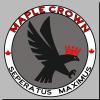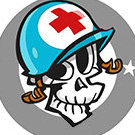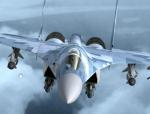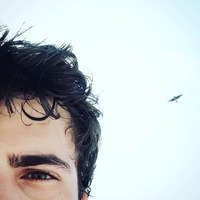Leaderboard
Popular Content
Showing most liked content on 02/19/2018 in Posts
-
11 points
-
6 points
-
4 points
-
4 points
-
4 points
-
3 pointsHellcats box art (from GiantBomb) Have you ever had the bug to play an old sim? Say, European Air War or Jane's Longbow. What about Hellcats Over the Pacific, or A-10! Attack? Wait… you may be saying, I've never even heard of these sims! I understand if you haven't, as these sims were released only for MacOS, an operating system most hardcore sim pilots have never even considered. In the 1990's, however, there was a very large, and rather unique simulation community built around the Macintosh. While many PC sims such as A-10 Tank Killer and Armored Fist were only starting to scratch the surface of "True 3D", with voxel graphics rendering low resolution textures, Mac developers knew they would have to take some risks to achieve the greatness that was already on full display on the DOS/Windows shelves of CompUSA and ElekTek. Their solution? A typical Mac developer response. They would sacrifice the then high resolution, "photo-realistic" textures for flat shaded polygons to create fully realized 3D worlds and models, including real-time shadows and highly accurate physics. From Wikipedia: "Hellcats was a major release for the Mac platform, one of the first 3D games to be able to drive a 640 x 480 x 8-bit display at reasonable frame rates in an era when the PC clone's VGA at 320 x 240 x 4-bit was the standard." Having only had my parent's Mac to play on, and being crazy about flying (thanks to them no less!) I dove into this world full bore. My first experience in this new world of flight was Microsoft Flight Simulator 4.0, a fantastic sim I taught myself how to play at the young age of five, mostly by trial and error. Soaring above the Chicago skyline in my Cessna 182RG was truly amazing for my young self, but something was lacking. That something was obviously guns. By 1991, I was six years old. With the combination of ever increasing hours of time spent in FS4 and the excitement of reading about the air to air victories from the just ended Gulf War, I was ready. During a trip to the store I saw the game I wanted, and I begged my parents to get it for me. Amazingly enough, they actually relented. Soon, I knew, I would be soaring over tropical locales and splashing Zeroes! Hellcats Over The Pacific was released in 1991 by Graphsim Entertainment, who would go on to release the excellent Hornet series a few years later, which will be the subject of a future write-up. Developed by Parsoft Interactive and coded by Eric Parker, it would become maybe the most popular sim ever released on the Macintosh. Sporting bright graphics, excellent physics and flight models, and rudimentary carrier ops it was, much like its namesake the F6F Hellcat, truly a beast to be reckoned with that outclassed and outdated all opponents. Bagging a Zero at the merge. You can see the rudimentary "radar" here (Photo courtesy of mobygames.com) Taking place on a large map of the Solomon Islands, it focused on the Battle of Guadalcanal and related engagements in "The Slot". The missions themselves were rather basic, with accordingly basic mission names. "Bomb Base" for instance had you bombing a Japanese held airfield, which would eventually become Henderson. "Scramble!" is pretty self-explanatory, take off, shoot down the G4M Betty while mixing it up with a pair of escorting Zeroes. Rarely were there more than just a few aircraft in any given scenario. Typically no more than four or five, including your aircraft, most likely to keep memory usage down. Only two missions ever had you flying with allied aircraft, the first an escort mission with a B-17 called, you guessed it, "Flying Fortress". And the final mission of the game, "The Duel", paired you up with ultimate Hellcat ace Cpt. David McCampbell (34 victories, including 9 in one sortie, and the Medal of Honor). Number two behind McCampbell (Photo courtesy of mobygames.com) A particularly grueling trial came in the form of the mission "Flat Top" where you needed to bomb and sink an opposing Japanese carrier. One bomb usually wouldn't do it, and it was hard to get both on target with the massive AAA fire from the surrounding task force. Sometimes this meant multiple sorties in a single mission, returning to trap on the carrier over and over till you finished. Since many flight sims don't include an in-mission re-arming mechanic, this made this fairly unique, especially considering the fact that in many missions you would be returning to the carrier, and not a nice long stretch of concrete. Trapping once is tough enough, but doing it multiple times per mission seriously heightened the challenge! Another tricky mission was "Divine Wind" where you needed to defend your carrier against kamikaze attacks. As the enemy aircraft spawned at a regular interval there was usually no time to return to base and rearm, necessitating careful ammunition and fuel management. With the carrier sinking, the mission is effectively over. (Photo courtesy of mobygames.com) But like all things, it was not without its problems. Chief among them was the seriously lacking draw distance, a common issue amongst many games in the nineties. It is not typically an issue in say, an RTS or corridor FPS shooter, but in flight sims, the farther you can push the draw distance, the better off you are, and the more immersive it becomes. Unfortunately, the distance in Hellcats was short even for the time, making strafing runs on enemy airfields with parked aircraft and long distance intercept missions harder than they probably needed to be. The work around was a sort of radar, in the center of the instrument panel. This radar gave a 360 view around the aircraft out to a few miles, with other aircraft represented as white dots. The enemy AI was also quite lacking. Most engagements typically quickly devolved into a tight turning fight that the Hellcat could easily win by use of the aircraft's flaps to gain a significant turning advantage over the opposing Zero. This was a feature the Hellcat did not have, but that ironically, many Japanese fighters did. The hit detection was spotty at close ranges, causing many bullets to simply pass through the opposing aircraft and simply drain away your ammo. At longer ranges accuracy was better, but many times the enemy would simply smoke then ditch, requiring close in strafing runs near the ocean's surface to get credit for the kill. I can still remember my first kill in any combat sim ever, a snapshot with a deflection angle of nearly 90 degrees. I turned sharply to the right to chase and was rewarded with a swiftly descending, and heavily smoking Zero. It's an image forever burned into my mind, and I was hooked. For better or for worse, I had begun a lifetime obsessed with the skill curve of the Combat Sim. It was a fun jaunt into the past writing this article. I even remembered most of the key bindings! If you're ever looking into the retro-sim scene yourself, don't count out the Macintosh platform. There are several other great sims from this era for the mac, a few of which will be the subjects of future articles. If anyone would like to know how to get into the world of emulating Mac or DOS games for a similar trip down memory lane, PM me. I'll get back to you as soon as I can! Thanks for reading, good luck, and good hunting.
-
2 points
-
2 pointsI looked at JSBSim when I was evaluating Flight Gear flight models. I think you will find that the numbers will not directly translate between the two flight engines. TK uses extensive tables so that you can plot correct, empirical data. So, if you have a NASA wind tunnel study or better yet a collection of curves/data points from live flight testing, you can usually tweak TK's flight models to match those results. If I recall correctly, JSBSim was much simpler. You start with a core set of numbers and the flight engine estimates all of the other values at various machs/altitudes. I don't recall how JSBSim handles transonic/supersonic mach numbers, but I don't recall being impressed. TK's flight models suffer first and foremost a problem with resolution. The original SFP1 flight models were tabulated in increments of 0.4 Mach. In general, this was adequate from Mach 0.4 to 0.8 and Mach 1.2+ where the curves are fairly linear and flat. If you fed the tables the correct numbers, you could get magical "1%" accurate flight models that seem to be the "gold" standard for flight sims. But a lot of things change quickly at very specific Mach numbers over the Mach 0.8 to 1.2 range. To model transonic fighters like the MiG-15, MiG-17, and F-86 accurately, the interval needs to be Mach 0.05. Even Mach 2 fighters like the F-4, MiG-21, and F-105 benefit from high resolution intervals over the transonic range. If TK's flight models could have been so much more accurate if they had supported varying the resolution as needed instead of a fixed interval between all data points. It is a pain in the butt to develop flight models with the original Mach 0.4 interval, and insufferable to use an interval like Mach 0.1 or smaller. The other problem with TK's flight models is that they can't show interference, such as between the wing and tail. The effectiveness of the tail can be greatly effected at higher AoA by the wing's airflow. The table for the horizontal tail (elevator, stabilator, etc.) is pretty straight forward based on the Mach and/or angle of attack. But the wing can cause the tail to see different speeds and/or angles than the air which originally hit the wing. So you have to choose between tailoring the tail control tables to normal flight conditions such as level flight or to reflect high AoA conditions. The F-100, F-101, F-104, and F-4 are all subject to problems based on this. In my F-4B flight model, I simply ignored the interference effects which combined with the Mach 0.4 table intervals left it quite inaccurate over the transonic range, but still did great at Mach <= 0.8 and ok at Mach >= 1.2.
-
2 points
-
2 pointsCL pylon is removable. USN/USMC Aggressors usually didnt use them. The flat shark nose and extended LERX are late-production F-5E features, I used to have details/dates on that when I researched F-5's some years ago. Nice website where you can look around for the modifications... http://www.the-northrop-f-5-enthusiast-page.info/index.html
-
2 points
-
2 points
-
2 points
-
2 points
-
1 pointIn a special meeting in the Hebrew cabinet in August 1987, the goverment presided by Yitzhak Shamir decided to stop the development of the IAI Lavi after defense budget had sikyrocketed. But in a twist of fate, almost at the end of the meeting a urgent message arrived trough diplomatic channels. Japan and Argentina will help to fund the IAI Lavi in exchange for techincal help and the permissions to build the plane in country. At this genereous offer, Shamir soon made a press conference presenting the country with the new situation and letting IAI enginners and pilots to continue the flight tests then underway. 5 years after that the plane was considered a huge succes with export orders to several countries as well as being a plane that meets all the old and new requirements being made by the IAF. Here we see the plane in a punitive strike in 1994 against Gaza strip. Model by AngelP, it need some work on skins, basicly weathering and stencils, if anyone wanto to help with that...
-
1 pointSince we seem to be so far behind in replacements for our CF188s...the Gripen was tossed around as a possible replacement.
-
1 pointOK. Thanks I'll replace it. I have an info sheet on an older Ryan drone and has a profile and upper view if this modeller is interested. https://www.google.ca/url?sa=t&rct=j&q=&esrc=s&source=web&cd=7&ved=0ahUKEwjHjqjYz7LZAhUFZKwKHbktByoQFghJMAY&url=https%3A%2F%2Fdocuments.techno-science.ca%2Fdocuments%2FCASM-Aircrafthistories-RyanKDA-4Firebeetargetdrone.pdf&usg=AOvVaw0tObe1TePlV1TtLtojWMCP
-
1 pointnot sure who made old one... but i know who made this.... so .... it is on CA...in download section Special Hercules Over Vietnam.. but there is no really target drone model...at least not yet...
-
1 point
-
1 pointHave now tested with the static/slow/fast/etc propnodenames commented out and the pump prop still spins well. I don't have the rotationaxis value in place so it should be fine to comment that out too....theoretically, I would say that dynamic streamers are possible, as Wrench outlined, although I am no streamer specialist - hopefully someone will figure out how that works. Von S
-
1 pointView File F-2H Banshee (Razbam) Updated data pack F-2 Banshee Updated data pack v1.1 This is a further update of the DATA.inis of the RAZBAM F-2 Banshee. In this updated data pack, there are changes in the data.ini, trying to achieve realistic performance specs. So changes are done in almost every aspect of the specs (weight, flightdata, engine thrust etc) for being as close to the real thing as possible. For using this pack you need to have downloaded first - the original RAZBAM Banshee (Go to RAZBAM website for more details) - the Banshee Tweeks Pak -for Razbam Banshees of Wrench https://combatace.com/files/file/14889-sf2-kaw-f2h-2-banshee-tweeks-pak-for-razbam-banshees/ https://combatace.com/files/file/15415-sf2-f2h-3-banshee-tweeks-pak-for-razbam-banshees/ https://combatace.com/files/file/15417-sf2-f2h-4-banshee-tweeks-pak-for-razbam-banshees/ Credis should go to - RAZBAM for the original release - Wrench for making this really usable in missions/campaings - Ravenclaw_007 for the AN-M30 bomb - Spillone for - at least - some of the sounds Thoughts for further upgrades - The AltitudeTableNumData & DryMachTableNumData are really very limited and are restricting realism. Please give me help to correct them. DONE - The F2H-3 (F-2C) is without wingtip tanks but in reality all the -2,-3,-4 models had the capability of carrying wingtip tanks. I am planning to substitute the LOD of the -3 with the -4 model (since these two were identical externally) but for doing so I am waiting your feedback.DONE INSTALLATION INSTRUCTIONS - Overwrite everything above v1.0. Place the banshee f2h4.LOD (which you can purchase from the RAZBAM website) in your F-2H3 folder. What's new in v1.1 - The Destroyed Model now it's the stock F-84F one. - The F3H-3 (F-2C) now uses the F3H-4 LOD. Indeed, the -3 also used more the wing tip tanks than not, since they had a minimal effect on overall performance. - Further updated engine data. - Corrected ground clearence for the F3H-2. - Corrected loadouts. Now the wing pylon can be loaded with bombs (historical). - Small touches here & there for better overall result. Issues - The -4 used a different radar than the -3 model that had also a different radar screen with different symbology (not a successful one, as it often mentioned). However, it seems that we have the -3 style radar screen for the - 4 model too. - In some sources it's stated that the -4 had 20% more range than the -3 model. I am not convinced for that. Most likely it had to do with the need for full throttle/max power more often than the -4 model in combat conditions, something which indeed reduced endurance. Therefore I kept the same radius for the -3 & -4 models. - The Canadians seldom used their wing tip tanks. I had a hard time to spot canadian F-2s with wing tip tanks when in actual service. The most likely explanation is that with the small canadian aircraft was too much to handle the take off of the approx. extra 1 ton of weight with the wingtips on the weak -3 model. If someone wants a tank-less RCN F-2, I can update the pack. However the final solution will be to add the tanks as loadouts. *** sQUADRONS [SquadronXXX] Name=VF73 DisplayName=VF-73 Jesters Nation=USN [SquadronXXX] Name=VF193 DisplayName=VF-193 Ghostriders Nation=USN [SquadronXXX] Name=VF870 DisplayName=VF-870 of Royal Canadian Navy Nation=CANADA Remember this is a freeware! Submitter FANATIC MODDER Submitted 02/18/2018 Category ini File Edits
-
1 point
-
1 point
-
1 pointYup, max up to 7 ALARMS on official RAF site. (And it's 3 on centerlines, 2 on inner tank pylons and 2 instead of tanks). So in practice, with tanks and without AIM-9 ... 5 ;-) So, what I did ... it's possible to load ALARMS on every pylon I saw on pics, but ... in loadouts I used them only 3 on centerlines for SEAD missions. You can add them for load, but they are not auto-loaded. Compromises ... ;-) ==================================== BTW, right navigator screen in bombing mode. Yup we'll have bombing radar. Not hi-precision device, but should be enought for dropping nukes, or 8 bombs salvo ;-)
-
1 pointThank you, Steve! You are absolutely right, they look pretty good in the air. It seems to me that in order to animate the streamer, this tape, at a least, must be composed of several parts in order to try to impose on it the effect of the flag. )
-
1 pointGuuru, operatively was rare see a GR.1/1B with the external shoulder rails on the inner pylons. This don't mean that is impossible ( I think all see the commercial/trial pics of Tonkas armed with 7/9 ALARMs) ,but only that,in a loadout.ini,personally don't will load anythings here. Also,the belly rack can be uploaded with up to 3 LGBs ( if not equipped with a targeting pod). I've in tha past a lot of first-hand infos from a Brit friend that was an RAF armourer int the ODS years,but unfortunately passed away a couple of years ago...
-
1 pointFunny how much time is gone when you fix something on a skin you don't like :) Traced all of the panel lines. Adjusting of camo lines can happen later.
-
1 pointThe best way to assess flight models is to know the math behind the flight engine and build a tool that reads the FM ini file and then generates the performance charts you are interested in evaluating. A long-long time ago, before I had a son, I created such a tool for SFP1. It was primitive and used brute force solutions that would light up your cpu for a while, but it worked. At one point, I needed to incorporate some changes to reflect what TK had added in a patch, and a nasty bug appeared in my code that I could never fix. I wanted to build a new tool from scratch that would support SF2, but I doubt I will ever have the time/motivation to do so. The next best thing is to build a spread sheet that allows you to manually solve the same equations my tool solved. It just takes time to build the initial spreadsheet, then go through the iterations of changing the speed (in mach) and/or other related parameters to find the solution to the problem. The only other solution is to fly in debug mode with a zero burn rate for fuel so that the weight doesn't change while you are flying and observing measured parameters.
-
1 point
-
1 point
-
1 point
-
1 pointThe other way around, I think the campaigns need to be updated to work with the IraqWA terrain, which is a lot better in many ways. The Iran-IraqWA terrain was a beta version, while IraqWA is the definitive version, with multiple fixes and additions.
-
1 point
-
1 point
-
1 point
-
1 point
-
1 point
-
1 point
-
1 point
-
1 pointSomewhere in Nevada.....Area51 unconfirmed....C L A S S I F I E D , circa 1985
-
1 pointKestrel FGA.2... in 1968! NATO needed new aerodynamical test flights with 6 initial modified Kestrels before the first RAF Harrier GR.1 deliveries!
-
1 pointI erased my whole Effects folder and then extracted the original one and reinstalled, my effects, tracers, muzzle flashes, are back. Thanks guys! Castillac approves!
-
1 pointBundesmarine F-2GN Super Fury ready for take off from Carrier "Walther Scheel" On course to soviet carrier group around TAKR Odessa Carrier hit, but plane damaged. Strike seen from wingman.
-
1 point
-
1 point
-
1 point
-
1 pointPlanned RNZAF P-51D and B-24J had the war in the Pacific contained. The RNZAF would have been re-assigned to the Southwest Pacific Theater and operated in the Philippians and Borneo. Changing from a US Navy command to a US Army command meant a change of aircraft type for the RNZAF. Japans surrender naturally meant the cancellation of the order apart from the first of the P-51D Mustangs that would go on to equip New Zealand's Territorial (Reserve) Air Force post war. Black theater bands are for the Philippians Theater.
-
1 pointScreenshots come from a personal mod Soviets East Germany and fictional Libyan republic vs NATO in North Africa the F-103 (Dhimar ? addon) is modified to make it a fictional what if had it served for the French as recon aircraft I know should change Finflash with something else :P
-
1 point
-
1 pointSupermarine Attacker then known as the 'Jet Spitfull' F.1 in RAF WWII service
Important Information
By using this site, you agree to our Terms of Use, Privacy Policy, and We have placed cookies on your device to help make this website better. You can adjust your cookie settings, otherwise we'll assume you're okay to continue..



































